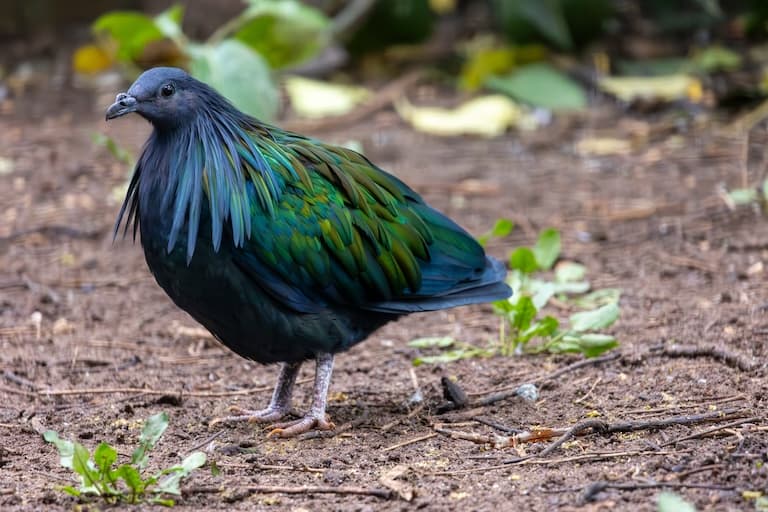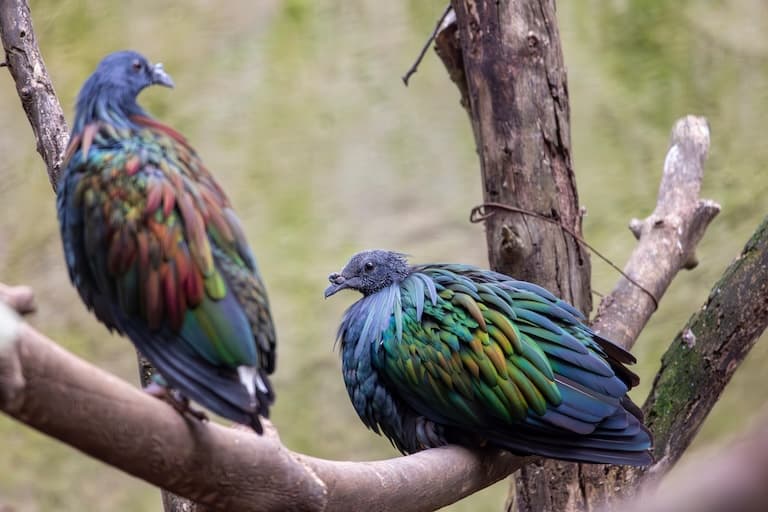Nicobar Pigeon Profile
Pigeons are generally considered pretty boring animals, at least at first glance. But historically, many of the weirdest, fastest and most adaptable birds have been pigeons. Even the Dodo, a 25 kg waddling caricature of bird kind was a pigeon.
And its closest relatives alive today are equally curious animals. With the face of a Trafalgar Square rock dove and the feathers of an Andy Warhol fright wig, the Nicobar pigeon is a reminder that Columbids should be known for more than bird ‘flu and shitting on limestone statues.

Nicobar Pigeon Facts Overview
| Habitat: | Wooded offshore islands and forages, close to lowland rainforest |
| Location: | Islands of South and Southeast Asia |
| Lifespan: | 12 years in the wild, up to 15 in captivity |
| Size: | Around 40 cm (16 in) long |
| Weight: | Around 600 g (21 oz) |
| Colour: | Dark slaty grey body with metallic blue-green and copper-bronze upperparts |
| Diet: | Seeds, fruit and buds, and occasionally insects |
| Predators: | Humans, white-bellied sea eagles, other raptors, snakes |
| Top Speed: | Fast in flight |
| No. of Species: | 1 |
| Conservation Status: | Near Threatened (IUCN) |
The Nicobar pigeon is likely the closest thing we have left to a Dodo.
Though the two look nothing alike, the Nicobar has its own interesting visage, and like the Dodo, it prefers to be left alone. Unfortunately, neither got their wish, and it’s looking like there will have to be a “closest living relative” of the Nicobar pigeon if things don’t change course.
Still, a new immigrant population is emerging in Australia. Whether this works out well for the bird without causing devastating effects to the unique island ecosystem remains to be seen.
Interesting Nicobar Pigeon Facts
1. They’re almost dodos
Since the extinction of the Dodo, there have been two contenders for its closest living relative: the Rodrigues solitaire, which unfortunately followed suit around a hundred years later, and then the Nicobar pigeon.
The fact that the Rodrigues solitaire laid only one egg, ate fruits, was monogamous, and cared for its nestlings supported its—and therefore the dodo’s—relationship to pigeons, and genetic investigations have supported this and identified the Nicobar as their closest relatives.
The fact that the Nicobar lives so impressively far from the African island habitats of the Dodo is a sign of their impressive dispersal ability, and the only confounding variable appears to be the presence of the Spotted Green Pigeon, Caloenas maculate, which may or may not turn out to be a subspecies of the Nicobar. 1

2. They’re organized
Unlike other pigeons (and pigeon taxonomists), Nicobars are remarkably ordered in their behavior.
When in flight, which, unlike the dodo, they do quite often, they form a healthy queue, and this is aided by a bright white tail tip, possibly acting as a guide to the bird behind.
These white tips, like the silver back of a gorilla or the balding head of an animal blogger, serve as a symbol of maturity, dignity, and (most importantly) fitness as a mate—immature Nicobars don’t have them. And won’t, until they grow up.
These birds are strong in flight and can travel long distances, which they do to separate their feeding grounds from the relative safety of their roosting areas, often on completely different islands.
While they do fly when necessary, these pigeons prefer the way of the dodo and like to walk around looking awesome. 2
3. They’re stunning
And awesome, they really do look! Nicobars are up there with the crowned pigeons in terms of beauty, covered in a rainbow of long, draped feathers that reflect in iridescent blues, greens, and oranges.
These colors likely look even more spectacular to their kin, who, like all birds, can see in ultraviolet wavelengths, too.
These bright colors appear different at a distance than they do close up, which might suggest they’re also used as a clever form of camouflage. 3

4. Guano Islands
In 1856, the US enacted a federal law that enables citizens to claim any island covered in bird shit for the United States government, as long as there was nobody already on it or within another country’s jurisdiction.
This was the Guano Islands Act, and while in practice, it’s almost irrelevant to the Nicobar Pigeon (who lives on a totally different continent from where most of the Guano Islands were disputed), it reflects just how many such islands there are and how significant they can be.
Small, desert islands like these are plentiful over volcanic hotspots, and birds are usually the first to arrive on them. Their poop builds up over time and, at least to the US and the UK in the ‘50s, turns into valuable imports of fertilizer.
Nicobar pigeons evolved on islands like this and so still prefer places without human settlements or American poop miners around. They’re island-hopping specialists, but unfortunately for them, so are humans.
5. There are lots of people around
Humans also feel pressure from other humans and tend to leave small islands in search of more space, more food, and a quiet night’s sleep.
Those humans who migrated onto the habitats of the Nicobar also took fondly to their coloured plumage, which they would steal, sometimes with the pigeon still in it, and sold the pigeons for both meat and as pets.
Even the pigeon’s gizzard stones, which are apparently also quite pretty, were used as justification for hunting the birds, and the population as a whole is now decreasing. 4
6. Habitat destruction is a problem too
The above threats are seriously impacting the prognosis for the species as a whole and are compounded by the relentless destruction of viable habitats, too.
Small islands are great for palm plantations, and illegal logging as a product of the corruption and lack of government oversight is a continued issue.
The species is now considered Near Threatened and on a downward trajectory.
7. They’ve made it to Australia
Fortunately for the species, they do well in captivity, and breeding programs have enough stock in the bank, held in zoos all over the world.
A potential Hail Mary from the wild population has also occurred on the Northern coast of Australia, where a number of sightings of this species have been reported for the first time.
Australia has a lot of troubles from invasive species, having been mostly isolated through millions of years of evolutionary history, so whether or not this proves to be a good thing remains to be seen.

Nicobar Pigeon Fact-File Summary
Scientific Classification
| Kingdom: | Animalia |
| Phylum: | Chordata |
| Class: | Aves |
| Order: | Columbiformes |
| Family: | Columbidae |
| Genus: | Caloenas |
| Species: | nicobarica |
Fact Sources & References
- Tim H Heupink (2014), “The mysterious Spotted Green Pigeon and its relation to the Dodo and its kindred”, Springer Link.
- “Nicobar Pigeon”, WWF.
- (2018), “Shining a Light on the Nicobar Pigeon”, Advanced Science News.
- Denise Bereford (2022), “The Nicobar Pigeon Gizzard Stone: Going Extinct For Jewelry”, Pigeon Pedia.
